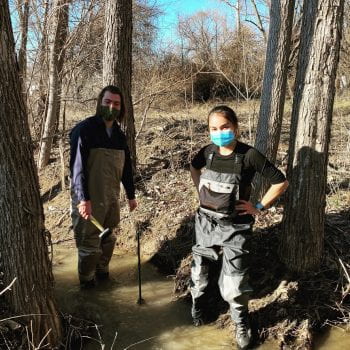We explore these links between process, form, and landscape evolution with a suite of methods, including by not limited to, laboratory experiments, numerical methods, field monitoring, and near-surface geophysics. We work at the interface of geoscience, granular mechanics, and solid mechanics to better characterize the behavior and response of natural systems in the face of the variability inherent in Earth’s climate system and geologic materials.
Controls on wave energy delivery on rocky coasts
Rocky coasts are typically considered high wave energy environments – but how is this delivered wave energy translated into coastal erosion? We are interested in understanding the transformation of delivered wave energy in the mechanical work that acts on cliff rock. Using a suite of methods, we aim to constrain the controls on wave energy delivery on rocky coasts with implications for coastal hazards and long-term landscape evolution.

“Unpacking” memory in fluvial landscapes
Landscapes encode signatures of their past history across a range of scales, from the structure of sediment grains on a riverbed to fluvial terrace sets recording cycles of aggradation and incision. What sets the memory across space and time in fluvial landscapes? How do these memory effects manifest themselves in fluvial responses to variable environmental forcing? Through a combination of laboratory experiments, field observations, and numerical methods, we are interrogating the feedbacks between climatic variability, landscape structure, and erosional response in river systems.

Rock damage feedbacks and bedrock erosion processes
Rock strength plays a significant role in governing the pace and dominant process of landscape evolution, in that it (1) provides the source of erosive tools through breakdown processes, and (2) modulates the efficacy of the erosive processes which lead to that breakdown. Thus, understanding the characteristic timescales of rock strength evolution and how external forcinga drive strength change is necessary to inform process-based models of landscape evolution across scales. We are interested in identifying and quantifying these surface process-rock strength feedbacks and their topographic consequences in fluvial and coastal bedrock landscapes.

Biological controls on the evolution of rocky coasts
Life dominates landscapes. However, the mechanistic links between geology and biology remain poorly understood. In coastal systems, kelp forests exclusively colonize rocky coastlines populated by sea cliffs and play a vital role in coastal ecosystems. Unlike most organisms that have evolved to reduce their size to withstand high-energy environments, kelp species evolved to be large and flexible and are thus able to endure high wave and current stresses. We are interested in quantifying the effects of kelp forests on buffering wave energy delivery, trapping fine sediment, and setting shore platform downwearing rates. By quantifying these effects, we aim to constrain the influence of kelp forests on the evolution of rocky coasts.

Erosion and landscape evolution in the Ozarks
Located in WUSTL’s proverbial backyard, the Ozarks have a rich geologic and tectonic history. Despite its long-lived tectonic stability, Ozark topography is still undergoing dynamic adjustment at the landscape scale. We are interested in understanding the structural controls on landscape evolution in the Ozarks. Further, the Ozarks are host to a number of actively eroding bedrock and alluvial channels, providing natural test sites to evaluate more general hyp0theses related to fluvial morphodynamics and erosion mechanics.

Intersection of geomorphology and environmental justice
We have partnered with the Centreville community in East St. Louis to focus on the causes and consequences of severe flooding in the community. We are developing a community-based approach to incorporate resident knowledge and experience into data collection strategies and in informing the direction of our research. We are working with Equity Legal Services, the St. Louis Metropolitan Equal Housing Commission, EarthJustice, and other stakeholders as part of this project. This project is currently funded by a collaborative NSF EAGER with Williams College.
